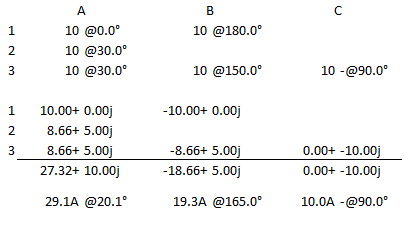Y'all must have been talking about two different things.
Ingenieur's circuit:
Van = 120.000 at 30.000d
Vbn = 120.000 at 150.000d
Vcn = 120.000 at -90.000d
Vab = 207.846 at 0.000d
Vbc = 207.846 at 120.000d
Vca = 207.846 at -120.000d
I_L1ab = 10.000 at 0.000d
I_L2an = 10.000 at 30.000d
I_L3ab = 10.000 at 0.000d
I_L3bc = 10.000 at 120.000d
I_L3ca = 10.000 at -120.000d
Ia = 36.327 at 22.089d
Ib = 26.458 at 160.893d
Ic = 17.321 at -90.000d
In = 10.000 at 30.000d
noting that:
I3a = 17.321 at 30.000d
I3b = 17.321 at 150.000d
I3c = 17.321 at -90.000d
Smart $'s circuit:
Van = 120.000 at 30.000d
Vbn = 120.000 at 150.000d
Vcn = 120.000 at -90.000d
Vab = 207.846 at 0.000d
Vbc = 207.846 at 120.000d
Vca = 207.846 at -120.000d
I_L1ab = 10.000 at 0.000d
I_L2an = 10.000 at 30.000d
I_L3ab = 5.774 at 0.000d
I_L3bc = 5.774 at 120.000d
I_L3ca = 5.774 at -120.000d
Ia = 29.093 at 20.104d
Ib = 19.319 at 165.000d
Ic = 10.000 at -90.000d
In = 10.000 at 30.000d
noting that:
I3a = 10.000 at 30.000d
I3b = 10.000 at 150.000d
I3c = 10.000 at -90.000d



